|
Sugg

|
Sugg
William Sugg & Co., Ltd.
Ranelagh Works, Chapter St.,
Westminster, S.W.1
England
|
"In the early 1890s I spent a short period with William Suggs. Gas wwas then
the primary lighting of the London streets. The gas burners used were "Bray" or "Fishtail". But
Suggs' had come into the market with their gas-pressure controlled burners, which
fast superseded other types. Even then they were a very enterprising firm. I well remember seeing
their showrooms at Charing Corss and seeign the machinery for operating high-pressure gas
lighting" - Thos. G. Bransford, Public Lighting #9, 1938
In 1932, along with their standard range of lanterns, the firm were selling Multi-Ray conversion
kits permitting an old lamp to be converted from the obsolete upright or large size inverted mantle to the more
efficient latest type new lamp with superheated small mantles and reflectors. The firm also made several
Governors of various type and the Distant Control Device. - APLE Exhibition Catalogue 1932
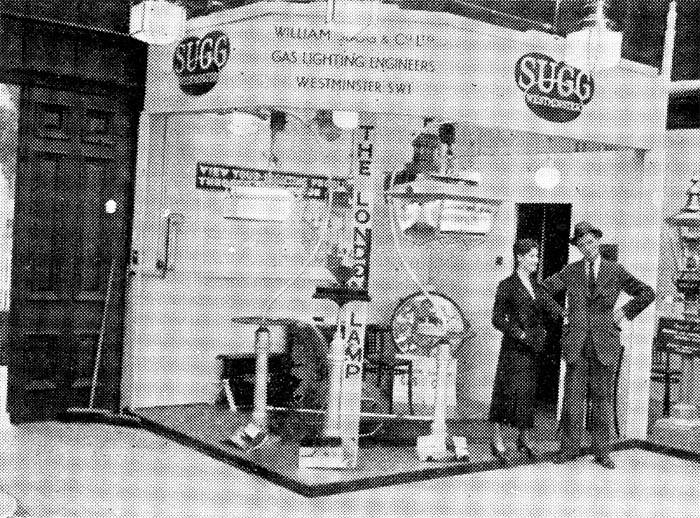
The firm's booth at the 1936 APLE Conference in Cheltenham.
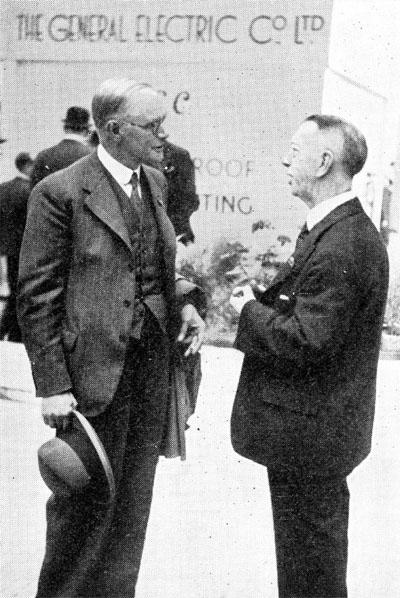
Philip Sugg (left) chats to T. E. Richie of the GEC at the
APLE Conference in Cheltenham.
The firm exhibited several lamps at the APLE's 1936 conference in Cheltenham. The London Lamp was given
the pride of place. Also exhibited were the Rochester, a low-pressure
Supervia and the new High Street lamp for exterior shop lighting.
Also of interest was an automatic Emergency Gas Switch which enabled emergency gas
lighting to be brought into operation immediately upon the occasion of an
electricity failure. - Public Lighting #3, 1936
They exhibited the London, High Visibility and
8000 Series lamps at the APLE's Conference in Folkestone. - APLE Conference Programme 1937
A number of examples of high efficiency lighting units for both Group "A" and Group "B" were exhibited in 1938. London,
Folkestone, Rochester and a three-way 8000 lantern were shown. A patent
Sugg-Horstmann Comet system of distant (or remote) control was demonstrated. (The Series Comet
also completely eliminated byepasses). A light control for Refuge Lamps was also shown along with a safety "cut-off" valve
to prevent the escape of gas in the event of an illuminated guard post being knocked down. (The safety cut-off was
invented by the Gas Light And Coke Company). - APLE Conference Programme 1938
Modified a photo electric cell for lighting street lamps between dusk and dawn. A recitified photo-electric caell is fixed
in a suitable position on the lamp and is connected with the main control box. The components in the box
include an electric relay, a 3-volt dry cell and a clockwork operated gas valve which incorportes a
switching device. When daylight falls below a pre-determined value, the current from the photo-electric
cell operates the relay, which allows a small current to flow from the dry-cell to energise an electro-magnet,
which operates the trip mechanism on the clockwork gas valve, which then turns to the "on" position
and lights the lamps. A similar operation occurs when the value of daylight increases to a pre-fixed
value and the lamp is extingushed.
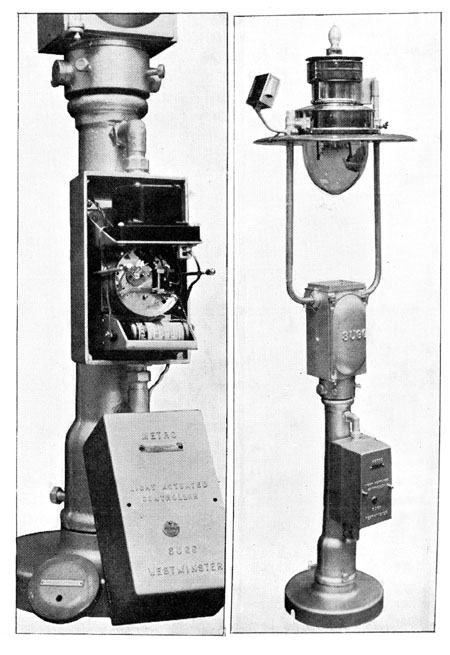
It can be used for refuge islands with centre lamp; and for all lamps
and signs on a roundabout. It is possible with Comet ignition to light all lamps up simultaneously.
The only attention required is the winding of the clockwork mechanism - about once every three weeks -
and the renewal of the battery - not more than once per year. The control was patented by
Mr. W. H. B. Hall, Mr. R. H. Whillock and the South Metropolitan Gas Company originally
for use in schools. It was developed by Sugg for street lighting in conjunction with
the Public Lighting Section of The Gas Light & Coke Company - Public Lighting #11, 1938
The possibility of an escape of gas igniting if a gas-illuminated bollard is knocked over was looked at
by the Public Lighting Section of the The Gas Light & Coke Company. They
devised an automatic cut-off valve which is being manufacturered by Sugg.
The valve is fixed to the service in the base of the bollard, preferably below ground level, and the
supply to the burner is conencted to it by means of an easily broken nipple, which ensures the valve
not being broken away from the service if the bollard is knocked down. The device itself is
diaphragm operated, the inlet gas passing to the underside of the diaphragm and thence through a valve to
the burner. The effective area of the valve is small in relation to that of the diaphragm. Pressure at
the burner is conveyed to the upper side of the diaphragm by a small bore tube, and under ordinary
conditions, with almost equal pressure both above and below, the valve is kept open by its own weight.
Immediate fracture of either the main supply or the small bore tube, the pressure above the diaphragm
is reduced to atmospheric, and the inlet pressure snaps the valve shut and keeps it in this position
until pressure is again applied above the diaphragm by means of reconnection. Owning to the success of
this device, it is now being fitted to all gas lighted bollards and guardposts. - Public Lighting #11, 1938
The new Highway lantern and the 8000 Series were both exhibited and extensively
described at the Glasgow Conference. - APLE Conference Programme 1939
One of several manufacturers who produced the Standard Gas Industry Fitting for converting gas lanterns to
comply with war-time starlight conditions. - Public Lighting #17, April 1940.
Their Westminster works was damanged by bombing in late 1940/early 1941. The firm assured all their clients that this would not
unduly affect their manufacturing obligations. - Public Lighting #20, January 1941.
The firm are exhibiting their well-known and tested Gas Lamps which they will be
able to supply first after stopping their war-time production. Three different
gas units are on display: the London B/2, Rochester and
Windsor. - APLE Conference Programme 1945
The most promient and up-to-date Gas Lamp is the B/3 "London" lamp. It includes improved modifications to
the top casing, and is being extensively used for modern street lighting, being primarily designed for
Group 'A' schemes. It has a special mirror glass optical system, which can be very easily and accurately
adjusted to obtain the best result according to the nature of the surface of the road. Alternatively, special
reflector systems can be supplied, these being a low cut-off system, and a back reflector to give unilateral
distribution. The Rochester lamp has a variety of applications and either suspension or upright form
can be employed. The specially constructed stormproof casing and remarkably high efficiency has produced a
splended record of trouble-free service with a minimum of maintenace costs. The 8000 lamp is shown with
two distinct forms of mounting. In one case it constitutes the ideal conversion unit for bringing old gas installations
up to date at the lowest possible cost. With the new Sugg C.U. concrete bracket and column it provides a completely
modern lighting unit, suitable for new housing schemes. The clean outline of this design will appeal to all as a great
improvement in appearance. The high efficiency of the lighting unit is already well known, and some
detail improvements recently made have reduced maintenance costs still further. There is also displayed a working
model of the Sugg Centralised Control System for gas street lighting which illustrates how Master Control
for any number of lighting units can be arranged: a relay pipe is provided to operate the relay valves of lamps,
which are equipped with either byepass or Comet ignition. - APLE Conference Programme 1946
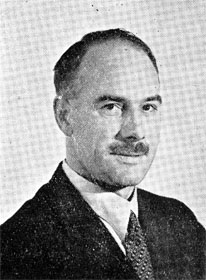
P. Crawford Sugg, B.Sc. (Eng.), A.C.G.I (above) - APLE Conference Programme 1947
Exhibited the Southport and 8000 on the streets of Southport for the APLE's Conference. - APLE Conference Programme 1947
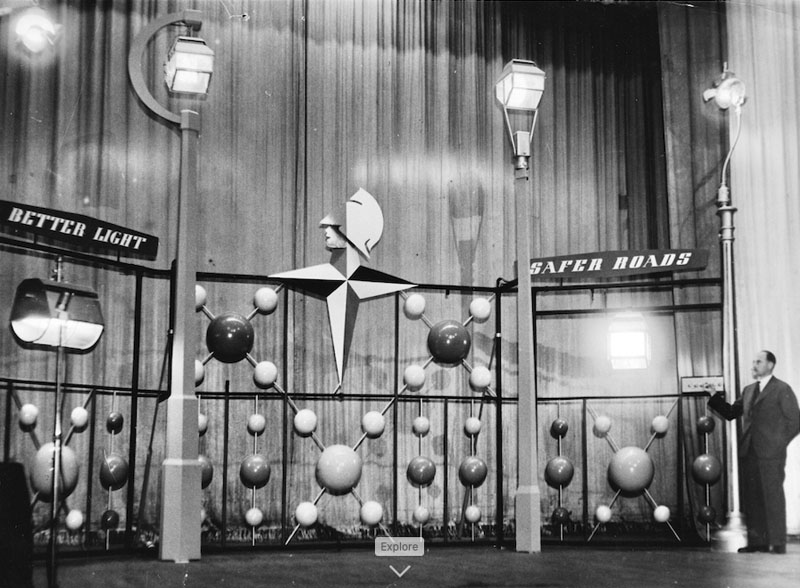
P. Crawford Sugg demonstrating the firm's equipment at the Festival of Britain in 1951.
Many thanks to Chris Sugg for the picture.
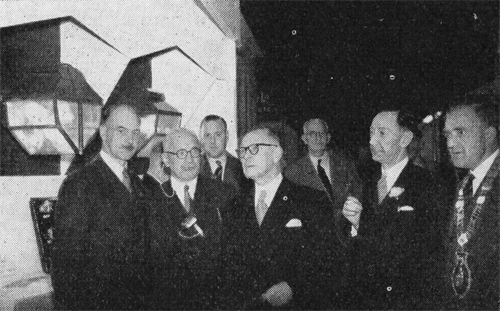
Sugg's stand at the 1953 APLE exhibition in Liverpool.
Left to right: P. Crawford Sugg, E. Stroud, Alderman A. Morrow, Alderman A. Critchley and C. C. Smith (President)
References:
The Illuminating Engineer 1928
APLE Exhibition Catalogue Blackpool 1932
APLE Conference Programme Folkestone 1937
APLE Conference Programme Bournemouth 1938
APLE Conference Programme Glasgow 1939
APLE Conference Programme Glasgow 1945
APLE Conference Programme London 1946
APLE Conference Programme Southport 1947
- External Links:
- Willaim Sugg & Co History (The Definitive Site by Chris Sugg)
- Grace's Guide
|



